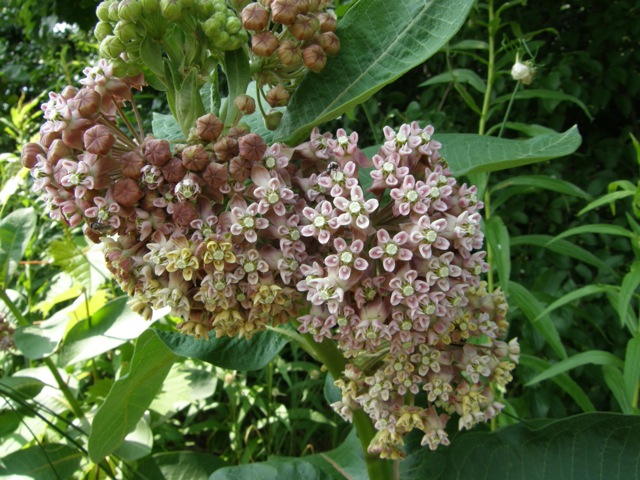apocynaceae, the dogbane family, formerly in asclepiadaceae, the milkweed family.
Description:
Plant:
Tall, robust, downy, generally unbranched, 2'-5', with many large
opposite leaves, and round clusters of small pink flowers in the leaf axils.
Flowers:
Pink, about 1/2", with five down-turned petals and a raised 5-part
central crown. Flowers in dense, round clusters ([[umbel]]s) in leaf axils.
Leaves:
Opposite, [[ovate]], 4"-10", thick, smooth-margined, and exuding milky juice when
damaged. Distributed thickly along stem.
Fruit:
A rough pod 2"-4" long generally borne sideways with respect to the stem,
and splitting when mature to release scale-like rows of flat seeds attached
to puffs of silky hairs.
Blooming:
June-July
Habitat:
Fields, waste places roadsides.
Comments:
Milkweeds formerly had their own family asclepiadaceae, Recent genetic studies
have resulted in this family being merged with the dogbane family
(apocynaceae), so the milkweed family no longer exists.
This milkweed is the primary food source in our area for the monarch butterfly
caterpillar. It accumulates toxins from the plant that make the adult
unpalatable to birds.
The milky juice, a latex, hardens on exposure to air, and gums up the
mouthparts of insects not specifically adapted to feed on it.
The flowers provide large amounts of nectar, and are attractive to many insects.
Milkweed is edible.
The young, unopened shoots, young leaves, and unopened flower buds can
be boiled in two waters to remove the bitter component and eaten as a
potherb. In this species, the young pods, while they are still firm
are similarly edible as the silk has not yet become stringy.
Where to find it:
Widely distributed in the drier fields and open areas of the park, much
more common than the more delicate [[swamp milkweed]], which is also found here
scattered near the pond.
